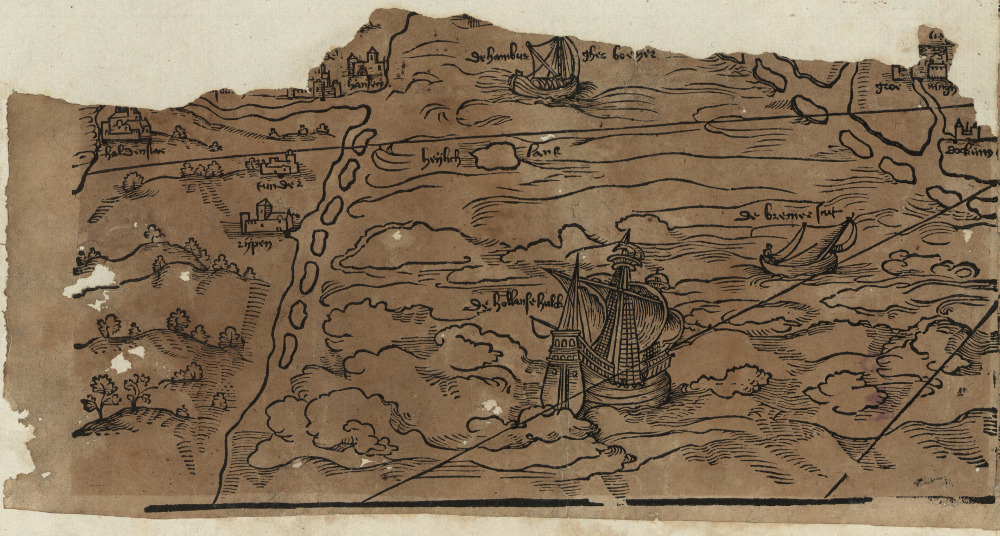Immer Weiter – Fragen und Antworten, Teil 2
Bart Holterman, 23 May 2023
(for English see below)
Hier beantworten wir die Fragen, die Besuchenden der Ausstellung „Immer Weiter – Die Hanse im Nordatlantik“ gestellt haben. In diesem zweiten Teil geht es um die Fahrt zwischen Norddeutschland und den Inseln und das Leben an Bord.
Wie lange war man damals von Bremen nach Shetland unterwegs?
Die Dauer der Fahrt zwischen Norddeutschland und Shetland war stark vom Wetter abhängig, vor allem von der Windrichtung und -stärke. Einige Tage bis einer Woche war man jedoch sicher unterwegs. Der Bremer Schiffer Brüning Rulves beschreibt zum Beispiel in seiner Memoiren eine Reise von Bremen nach Shetland im Jahr 1551, die vier Tage im Anspruch nahm.
Wie sicher waren die Schiffe im Vergleich zu heutigen Schiffen? Gab es ein Rettungskonzept?
Obwohl die meisten seefahrenden Schiffe sehr stabil gebaut waren, war die Seefahrt sehr viel gefährlicher als heutzutage. Dabei war es nicht sosehr der Bau des Schiffes, sondern die Elemente, die die größte Gefahr darstellten. Das Risiko in einem Sturm zu geraten und Schiffbruch zu erleiden war reell. In so einem Fall gab es kein Rettungskonzept, und konnte man nur hoffen, es zu überleben.
Haben sich die Leute an Bord mal geprügelt?
Das Zusammenleben vieler Leute auf engstem Raum während eines langen Zeitraums führte selbstverständlich zu Spannungen und nicht selten auch zu Prügeleien. Unter anderem aus diesem Grund herrschte an Bord eine strikte Hierarchie, wobei der Kapitän die oberste Befehlsgewalt hatte. Laut dem hansischen Seerecht war es ihm erlaubt, seine Besatzungsmitglieder (einmal) zu schlagen. Trotzdem liefen solche Situationen manchmal aus dem Ruder, wie zum Beispiel bei dem Tod des Bremer Schiffers Cordt Hemeling in Shetland im August 1557.
Was hat man damals an Bord von Schiffen gegessen und getrunken?
Auf längeren Reisen konnten natürlich keine leicht verderbliche Nahrungsmittel mitgenommen werden. Deswegen hat man vor allem getrocknete oder gesalzene Lebensmittel gegessen, wie Schiffszwieback und gesalzenes Fleisch. Auch Stockfisch und getrocknete Erbsen und Bohnen werden regelmäßig in Proviantlisten erwähnt. Getrunken hat man dabei hauptsächlich Bier. In Rechnungen für Seereisen wird regelmäßig einen Unterschied zwischen Schiffsbier gemacht: Bier das man an Bord getrunken hat bzw. das als Handelsware dienende Bier.

English version
Here we answer the questions which were asked by visitors of our exhibition „Immer Weiter – Looking In From The Edge“. This second part bundles the questions about the journey between Northern Germany and the islands and life on board.
How long did it take to travel from Bremen to Shetland in those days?
The duration of a ship’s journey depended for a large degree on the weather conditions, especially the wind direction and speed. A couple of days until a week was a likely duration for the journey from Northern Germany to Shetland. For example, the skipper Brüning Rulves from Bremen mentions in his memoirs a journey from Bremen to Shetland in 1551 which lasted four days.
How secure were historical ships in comparison to modern ships? Was there a rescue plan?
Although most seagoing ships had quite sturdy constructions, seafaring in the late Middle Ages and the early modern period was much more dangerous than nowadays. It was not so much the construction of the ship, but the elements which were dangerous. There was a high risk of getting caught up in a storm and to suffer shipwreck. In those cases there were no rescue concepts; one could only hope to survive it.
Did the people on board fight now and then?
The cohabitation of many people in a cramped space during a large period of time of course led to tensions, and not rarely to violence. Among others for this reason, a tight hierarchy prevailed on board, with the highest authority in the hands of the captain. According to Hanseatic maritime law, he was allowed to hit the others on board (once) as a disciplinary measure. However, this didn’t prevent the violence getting out of hand sometimes, such as in the case about the death of Bremen skipper Cordt Hemeling in Shetland in August 1557.
What did they eat and drink on the ships back in the day?
Perishable foodstuffs of course could not be taken on long journeys. For this reason the people on board mostly lived on dried and salted food, such as ship biscuits and salted meat. Dried peas and beans and stockfish are other examples of food which are regularly listed as provision on ship journeys. It was mainly washed down with beer. Accounts for fitting out merchant ships regularly make the distinction between ship beer and merchant beer, of which the former was drunk on board, whereas the latter served as merchandise.
Posted in: Exhibition, General
Comments